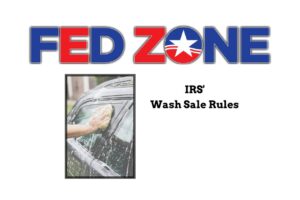Edward Zurndorfer explains the how the IRS wash sale rule works

Edward A. Zurndorfer –
An investor may have “seller’s remorse” losing money as a result of selling an investment (for example, a stock, a bond, an “open-ended”- mutual fund or an exchange traded fund) in a depressed securities market. The investor may want to salvage a portion of his or her losses in order to retain some of the investment that was sold for a loss and buying the same investment back at a cheaper price. However, if it happens that when an investor sells a particular investment at a loss, it is important for the investor to avoid replacing the investment with a “substantially” identical investment 30 days before or 30 days after the sale date. This is called the IRS’ “wash-sale” rule. Running afoul of the “wash sale” rule can result in an unwanted IRS tax bill. This column explains the how “wash sale” rule works.
A “wash sale” occurs if an individual sells an investment at a loss and, within 30 days before or 30 after the sale, directly or indirectly: (1) Purchases the identical investment, (2) acquires the substantially identical investment in a fully taxable trade or, in with stock investment acquires the same stock through a reinvested stock dividend; or (3) enters into a contract or option to acquire the substantially identical investment.
When a “wash sale” occurs, the (capital) loss is not allowed under IRS rules. In place of the disallowed loss, the amount of the disallowed loss is added to the “cost basis” of the substantially identical investment that is purchased. The holding period of the investment includes the holding period of the investment sold. The following examples illustrate:
Example 1. Sandy purchased 200 shares of ABC stock for $20,000 ($100 per share) in November 2019. On March 23, 2020, when the stock market dropped, Sandy sold all 200 shares of ABC stock for $15,000 ($75/share), resulting in a $5,000 short-term capital loss. In early April 2020, Sandy decided to take advantage of the lower ABC stock price of $70 per share and repurchased 100 shares of ABC stock for $7,000. Since Sandy bought identical ABC stock within 30 days of the sale of the 200 shares of ABC stock sold on March 23, 2020, she cannot deduct the $5,000 loss. The new shares of ABC stock have a cost basis of $9,500 ($7,000 plus $2,500*)
*Sandy sold 200 shares resulting in a $5,000 capital loss. Since Sandy bought repurchased 100 shares of ABC stock, she can use half of the $5,000 loss, or $2,500, to add to the cost basis of the repurchased shares.
Example 2. Benjamin owns 100 shares of DEF stock that he bought for $20 per share. In July 2020, the DEF stock paid dividends that Benjamin reinvested to purchase additional shares of DEF stock. In August 2020, Benjamin sold five shares of DEF stock at $10 per share, resulting in a capital loss of five times ($10 less $20), or a capital loss of $50. Benjamin cannot use the $10 capital loss to apply towards any capital gains. This is because the dividends reinvested to purchase additional shares of DEF stock in July 2020 occurred within 30 days of the sale of the five shares of DEF stock. Therefore, the “wash sale” rules apply, and the $50 loss is disallowed.
What Happens if the Number of Shares of Substantially Identical Stock Purchased is Less than the Number of Shares Sold?
If the number of shares of substantially identical stock purchased is less than the number of shares sold, the stock owner must determine the particular shares of stock to which the “wash sales” rules apply. In particular, the stock owner must match the shares of stock sold with an equal number, up to the total of the identical shares bought. Also, the shares should be matched in the same order as they were acquired. The following example illustrates:
Example 3. Michael buys 100 shares of XYZ stock on October 20, 2019 for $5,000. On December 28, 2019, he buys 25 more shares for $1,200. On January 8, 2020, Michael sells the 100 shares purchased in October for $4,400. Michael has a $600 (short-term) capital loss on the sale. However, since 25 shares of the identical stock were purchased within 30 days before the sale, because of the “wash sale” rules Michael cannot deduct the capital loss on the 25 shares sold (equal to: 25/100 times $600, or $150). He can deduct the loss on the other 75 shares (equal to: 75/100 x $600, or $450). The cost basis of the 25 shares bought on December 28, 2019 is increased by the $150 nondeductible loss to $1,350 ($1,200 plus $150).
With respect to buying stock within a traditional IRA, the IRS in Revenue Ruling 2008-5 ruled that buying stock in one’s traditional IRA can result in a capital loss sustained by the stock owner in a non-retirement account to be subject to the “wash sale” rules. However, the stock owner’s cost basis in the traditional IRA is not increased by the amount of the disallowed loss.
Finally, brokerages, clearing houses and any other types of companies handling the sales of securities must indicate any “wash sales” incurred by an investor by entering the disallowed loss in Box 1g of the investor’s Form 1099-B Proceeds from Broker and Barter Exchange Transactions) if the sale and purchase occurred within the same account.
At this time of year when many investors are seeking to sell capital assets owned for investment purposes (stocks, bonds, ETF’s, mutual funds) at a loss in order to generate some possible tax savings for 2020, it is important that these investors keep in mind the “wash sale” rules. Investors are highly encouraged to first speak with their financial advisors concerning whether selling a particular investment is in line with their financial goals. They should also seek professional tax advice concerning the tax consequences of selling their investments, including answering any questions about possible “wash sales”.
You Might Also Enjoy This Podcast
Edward A. Zurndorfer is a CERTIFIED FINANCIAL PLANNER™ professional, Chartered Life Underwriter, Chartered Financial Consultant, Chartered Federal Employee Benefits Consultant, Certified Employees Benefits Specialist and IRS Enrolled Agent in Silver Spring, MD. Tax planning, Federal employee benefits, retirement and insurance consulting services offered through EZ Accounting and Financial Services, and EZ Federal Benefits Seminars, located at 833 Bromley Street – Suite A, Silver Spring, MD 20902-3019 and telephone number 301-681-1652. Raymond James is not affiliated with and does not endorse the opinions or services of Edward A. Zurndorfer or EZ Accounting and Financial Services. The information has been obtained from sources considered to be reliable, but we do not guarantee that the foregoing material is accurate or complete. While we are familiar with the tax provisions of the issues presented herein, as Financial Advisors of RJFS, we are not qualified to render advice on tax or legal matters. You should discuss tax or legal matters with the appropriate professional.

